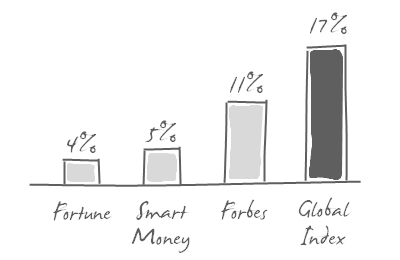Another new year has begun, which means the financial media’s latest “Where-to-Invest-Now” guides are coming to newsstands near you. As usual, headlines will look something like “Ten Stocks to Buy Now” and “Five All-Star Mutual Funds.” It seems like a good time, therefore, to review an important golden rule: You can’t believe everything you read.
Why? There is a lot of hype behind the headlines. Hot stock tips and savvy fund manager forecasts attract attention and spur sales. They don’t, however, help investors. We believe warnings similar to those in the pharmaceutical industry should be required. Warnings like, “Side effects include underperformance,” “Contents may impair judgment,” and “Do not operate large 401(k) balances after reading.” Since these aren’t likely to appear, the best way to caution investors might be to review last year’s predictions:
Fortune Magazine consulted a team of Wall Street hot shots to produce “Ten Best Stocks for 2012.” Unfortunately for readers, in a year when the S&P 500 returned 16%, half of Fortune’s picks actually lost money. 1 Goodyear Tire declined by 3%, Enbridge Energy lost 13% and Intel fell 16%. The average return for Fortune’s “Ten Best”? Four percent—12% less than the return of the S&P 500.
SmartMoney published its own “Where to Invest” guide, in which it promoted “Ten Juicy Picks for a Tough Economy.” 2 They predicted the world would drive more cars, become more “wired,” and “eat more protein” in the coming year. As it turned out, this “audacious” forecast was merely a reflection of the obvious (and thus already incorporated into prices). A portfolio of SmartMoney’s ten daring picks returned just 5% for the year, while the benchmark for global stocks rose 17%.
Longtime Forbes columnist Ken Fisher gushed, “This year is going to be beautiful.” He then went on to recommend five stocks readers must buy. 3 Indeed, Fisher’s five picks rose an average of 11%, a handsome return by many standards. But when compared to the global stock benchmark—which returned nearly 6% more—Fisher’s selections seem rather homely.
What’s the takeaway? Instead of seeking to predict the unpredictable or attempting to identify an “expert” who can, investors should focus on things they can control—asset allocation, minimizing costs and taxes, and staying disciplined. After all, a market pundit’s view of the future may be entertaining, but following that advice sure can prove costly.
1 Birger, Jon. “10 Best Stocks for 2012.” Fortune Magazine. December 26, 2011.
2 O’Brien, Elizabeth and Salisbury, Ian. “Where to Invest 2012” SmartMoney. December 28, 2011.
3 Fisher, Ken. “Give ‘Em The Finger.” Forbes.com. January 3, 2012.

